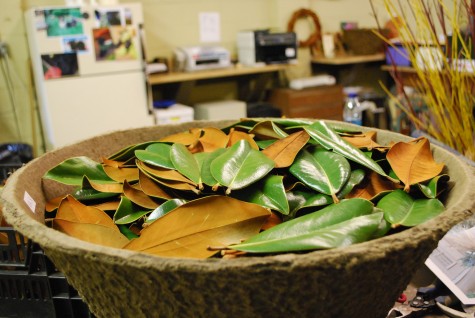
I had casually suggested to a client in December that her need for a pair of topiaries that would fit in a small and tall l-shaped space between a doorway and a bookcase might be easily handled with magnolia. I could imagine that a topiary some 6 feet tall, and very thin would gracefully, but noticeably fill the spot. The Magnolia Company was glad to oblige; they sent me a case of branches. The first order of business-remove all of the leaves from the branches, and grade them by size. Petite, small, medium and large.
 There are leaves in this world that do all sorts of good, beyond their life in a garden, or on the dinner table. Eucalyptus comes immediately to mind, as does integrifolia. They do the heavy work of bringing a sense of the garden indoors in spaces or places that cannot support living plants. Give me a topiary from dried or preserved leaves-never ever buy me a house plant. I like to look in the winter, not look after. Once I cut the stem from a magnolia leaf, I can shape it, and glue it to a form. Should I be graceful with my cutting, you would never spot that I had changed its shape. As this client favors very formal and precise shapes, the core of these topiaries would be a stout bamboo pole.
There are leaves in this world that do all sorts of good, beyond their life in a garden, or on the dinner table. Eucalyptus comes immediately to mind, as does integrifolia. They do the heavy work of bringing a sense of the garden indoors in spaces or places that cannot support living plants. Give me a topiary from dried or preserved leaves-never ever buy me a house plant. I like to look in the winter, not look after. Once I cut the stem from a magnolia leaf, I can shape it, and glue it to a form. Should I be graceful with my cutting, you would never spot that I had changed its shape. As this client favors very formal and precise shapes, the core of these topiaries would be a stout bamboo pole.
 The petite leaves formed the top. Most of the lower portion of the leaves were cut away. Succeeding leaves were spread with hot melt glue, and applied in overlapping rounds. This is a little hard to explain with words. but I glue some leaves flat-others I scrunch the bottom, as if I were ruching, or smocking them. This curves the leaves from side to side. The brown bruises you see in this picture-the heat from the glue. These heat marks need to be covered by the next round of leaves. This initial glueing I did on the bench, but every so often I would stand the pole up. The construction of any ornament so depends on the view. Leaves at eye level read entirely differently than leaves overhead.
The petite leaves formed the top. Most of the lower portion of the leaves were cut away. Succeeding leaves were spread with hot melt glue, and applied in overlapping rounds. This is a little hard to explain with words. but I glue some leaves flat-others I scrunch the bottom, as if I were ruching, or smocking them. This curves the leaves from side to side. The brown bruises you see in this picture-the heat from the glue. These heat marks need to be covered by the next round of leaves. This initial glueing I did on the bench, but every so often I would stand the pole up. The construction of any ornament so depends on the view. Leaves at eye level read entirely differently than leaves overhead.
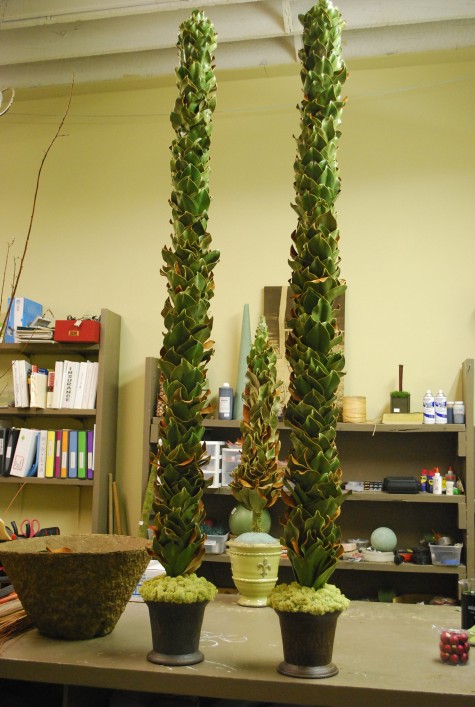 My work bench is at a height convenient for me to work on a project at eye level. I may move sculptures such as these to the floor, or onto a stool, depending on what I need to see clearly. My client’s antique iron pots had no trouble handling the weight of the pole, and the leaves. This picture catches the sculptures at a juvenile, and therefore awkward time. Magnolia leaves move, curl, and twist as they dry. Only the bottom of the leaf is secured with glue. The natural drying process I cannot exactly predict-that is a big fluid situation.
My work bench is at a height convenient for me to work on a project at eye level. I may move sculptures such as these to the floor, or onto a stool, depending on what I need to see clearly. My client’s antique iron pots had no trouble handling the weight of the pole, and the leaves. This picture catches the sculptures at a juvenile, and therefore awkward time. Magnolia leaves move, curl, and twist as they dry. Only the bottom of the leaf is secured with glue. The natural drying process I cannot exactly predict-that is a big fluid situation.

Three days later, these magnolia columns are evening out. Why is this? The leaves are moving and changing shape as they dry. I did my best to plan for this phase. Predicting the curl and the fan out-very difficult. I do the best I can, given my experience with these leaves. The construction of these topiaries is not unlike the construction of a landscape. Any move you make needs to take into account growing, and maturation. There is no substitute in landscape design for a vision of what the future might bring. A showroom in Atlanta carries faux magnolia leaves by the box. I could not bring myself to buy them, even though they would never crack or break. The natural magnolia leaves in their dry state have a grace and beauty that makes taking care of them worth the trouble.
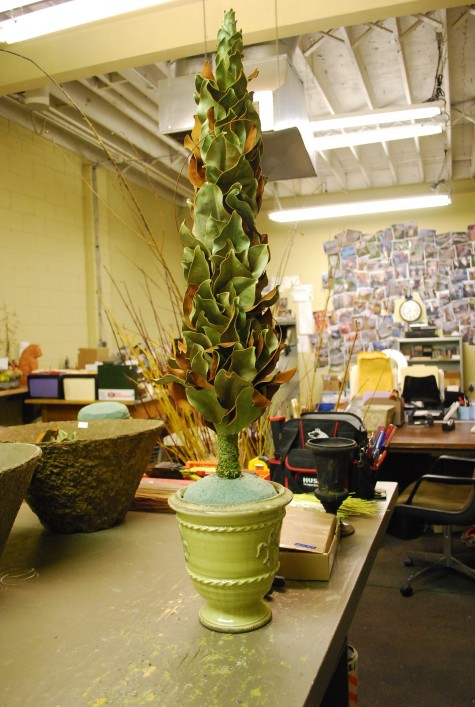 The leaves are easily manipulated when fresh; the dry leaves have a mind of their own. This topiary was constructed initially with fresh leaves, and then infilled with completely dry ones. This makes it easy to control the finished overall shape.
The leaves are easily manipulated when fresh; the dry leaves have a mind of their own. This topiary was constructed initially with fresh leaves, and then infilled with completely dry ones. This makes it easy to control the finished overall shape.
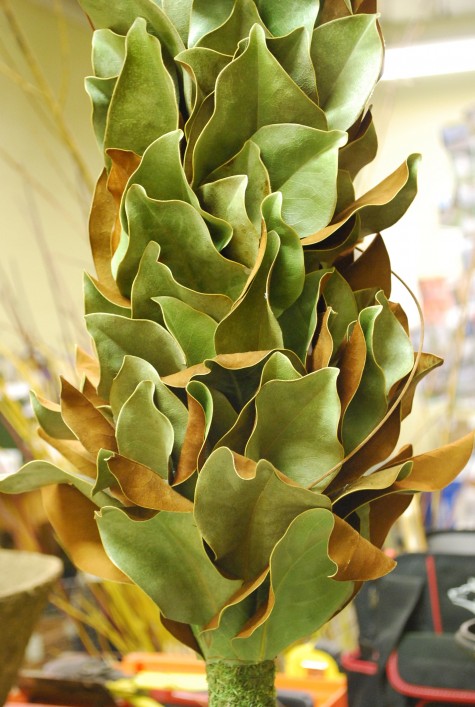 The stalk of this topiary, a wood stick covered with moss. The stick is straight and stable, and sharpened at the top.
The stalk of this topiary, a wood stick covered with moss. The stick is straight and stable, and sharpened at the top.
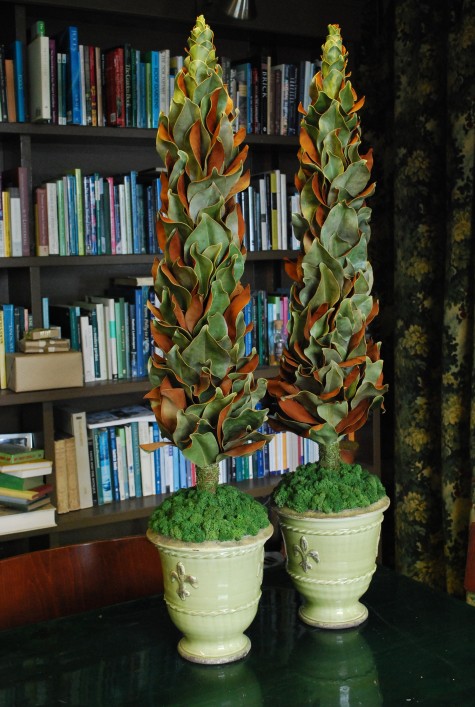
Dark green reindeer moss is glued over the dry foam form that fills the pots. Preserved with glycerine, it will retain its color and shape indefinitely. A pair of magnolia garlands left over from the holidays made three topiaries for the shop. All that’s needed now-the finishing touchup on those leaves.
you are brilliant….honestly, your work is worthy of some kind of art show.
how did you keep the magnolia leaves from becoming brittle when they dried?
nanne
Dear Nanne, there is nothing I can do to prevent them from becoming brittle. Maintaining the topiary means being careful that they do not get banged around or bumped into. I had a client bring back a topiary made from dry integrifolia leaves last week-her kids knocked it off a cabinet with a ball. It will be really tough to repair. But on the upside, I have had magnolia wreaths last for years, with careful handling and storage. Even wreaths that spend 2 months outdoors on the front door. Thanks for your kind words! Deborah
LoVe! Thanks so much for your posts. My mom and sister live in your area. I usually visit them in June every year. You’re on my list of places-to-go, people-to-see!
Dear Kynda, I am so pleased you visit. Our June is looking to be good-see you then. Deborah
AmaZing!!
Amazing and creative work. Love it!!!!!